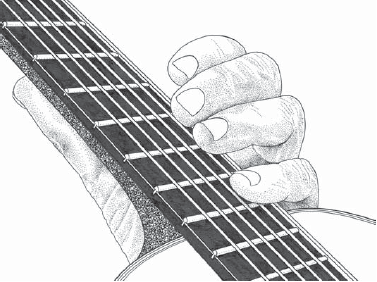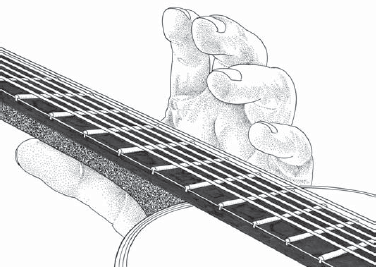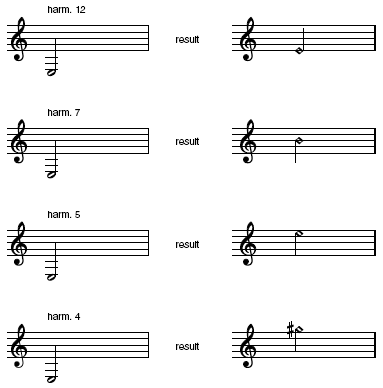Natural Harmonics
Now we can tackle a really interesting piece, but first we need to learn one
more technique— natural harmonics. This is quite easy once you get the feel of it.
When a string is touched lightly by a left-hand finger at exactly half its length
and then plucked by the right hand, both halves can be made to vibrate, producing
a bell-like sound.
The secret is to take the left-hand finger away the instant the note has been
played.
Notice in the first diagram that the finger is not on its tip but is parallel
to the fingerboard. This makes it possible to touch several strings at once.
The second diagram shows the finger which has been quickly lifted away once the
harmonic was played.

In position to play a harmonic

The finger is lifted quickly after the harmonic is played.
Try this out now, because you will need it for the piece below.
- Place the finger lightly as shown, just touching the first string right
above the twelfth fret.
- Play the first string with a rest stroke about an inch away from the bridge.
Playing closer to the bridge makes stronger harmonics.
- Take the little finger off to allow the string to vibrate.
If you leave the finger on too long, the sound will be deadened. Next, try the
same procedure but do it on the second and third strings. Finally, when you feel
well synchronized, try for a chord on the top three strings. Obviously you cannot
use a rest stroke with the right hand— just play the chord with i, m, and a.
The harmonic at the twelfth fret has the same pitch as a normal note played there.
However, harmonics are often written with open strings, and a number for where to
touch the string. The abbreviation harm. (for harmonic) or arm. (for armonico) is
customarily used.

The harmonic at the twelfth fret is the strongest and easiest to play. Progressively
weaker harmonics are found at the seventh, fifth, and fourth frets, with results
as shown. These are shown doing the harmonics on the bottom string. The harmonic
at the fourth fret is quite hard to sound clearly, and necessitates playing near
the bridge with the right hand.

The study below, attributed to Francisco Tárrega, gives the opportunity to explore
some higher notes and also to practice the harmonics. Try to use the notation, since
this indicates fingering, bars, and so on.
The a, m, i arpeggio will be good practice for the Romance later on.
|